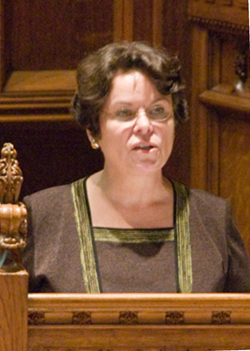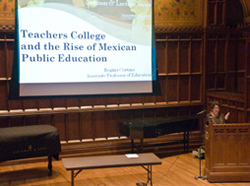Dewey's Impact on Mexican Education
Regina Cortina explains Dewey's export during TC's Cremin Lecture
Regina Cortina delivers TC’s Cremin Lecture
The story of how John Dewey’s philosophy was exported to China is well-documented, but there is another equally fascinating example of Dewey’s international influence. As Regina Cortina, TC Associate Professor of Education, explained during her talk as a part of the Lawrence A. Cremin Seminar and Lecture Series, two of Dewey’s students were instrumental in establishing Mexico’s rural schools.
Moisés Sáenz and Rafael Ramírez studied with Dewey at Teachers College in the early 1920s. They returned home to Mexico, where they worked in the Secretaría de Educación Pública (the Mexican Ministry of Public Education) and used what they had learned from Dewey to help shape Mexican schools. The violence of the Mexican Revolution had ended in 1921, and the Secretaría de Educación Pública faced the challenge of creating public schools that would incorporate widely-varied cultures and reach rural populations. Cortina explained that, though they are not well remembered today, Sáenz and Ramírez were key players in achieving those goals.
Sáenz wrote that he and Ramírez developed schools based on “motivation, respect for personality, self-expression, the project method, learning by doing, democracy in education”—all principles that John Dewey espoused. Sáenz was especially concerned with integrating the community into the schools and fulfilling what Dewey termed “the full social ends of education.”
Sáenz’s approach stood in stark contrast to that of Jose Vasconcelos, the man responsible for the Bibliotecas Populares—the public library system. Cortina said that Vasconselos, the first Minister of Education in Mexico, believed “there existed a prescribed body of knowledge that an individual must acquire in order to be educated,” an idea squarely at odds with Dewey’s conception of an educated person as someone who is reflective and engages in a process of learning through inquiry and experience. In contrast to Vasconcelos, Sáenz and Ramírez worked to build rural schools where the students were active participants in their education.
The educational system that Sáenz and Ramírez help to develop operated in Spanish, and Cortina acknowledged the oft-leveled charge that this hastened the obliteration of indigenous languages and cultures. However, she also pointed out the challenges of building an educational system from the ground up and the difficulty of building a nation out of a diverse collection of cultures.
Ultimately, Sáenz and Ramírez believed in education that served the community rather than the interests of the government. As Cortina explained, they were part of a movement in which a “new form of civil society came into being, challenging the closed hierarchical and expressly Catholic society that Mexico inherited from the colonial era.”
In 1926, as John Dewey was preparing for his first trip to Mexico, Sáenz said, “John Dewey has gone to Mexico. He was first carried there by his pupils at Columbia. He went later in his book The School and Society. It’s a book well known and loved in Mexico. And now he’s going personally.”
To view Cortina’s entire Cremin lecture, visit http://bit.ly/hnSV21
Published Monday, Dec. 20, 2010

